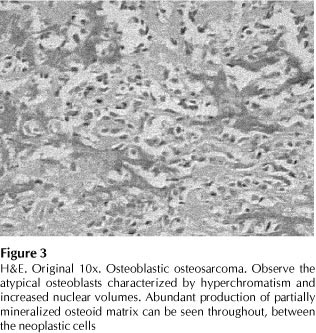Osteosarcoma is defined as a bone matrix-producing malignant mesenchymal tumor. It is relatively rare among domestic animals, but corresponds to 85% of all malignant bone tumors in dogs. To study canine osteosarcoma in animals living in Brazil and correlate the clinical-morphological findings with prognosis, forty-six cases of dogs with osteosarcoma were studied retrospectively out of a total of 56 malignant primary bone tumors on file. The animals were assessed in terms of age, sex, breed, topographic tumor distribution, and presence of metastases at diagnosis. The tumors were classified histologically by the method of Pool¹. Osteosarcomas corresponded to 82% of primary malignant bone dysplasias in the sample studied. Age ranged from 6 months to 14 years (C = 8 y), sex: 32 F/18 M; breed: large dogs (86%), topographic location: appendicular skeleton (64%), axial skeleton (28.5%) and extraskeletal (7.5%); presence of metastases in 17.4%. Histopathology: osteoblastic (32.6%), chondroblastic (9.6%) and telangiectatic (5.8%) patterns; combined: 52%. Osteosarcoma mainly affects adult females. Breed is a predisposing factor, the appendicular skeleton is most often involved, and an osteoblastic histological pattern predominates. The lungs are a common site of metastasis, with pure-bred male dogs being most predisposed regardless of the morphological pattern of osteosarcoma.
Oosteosarcoma; Dogs






